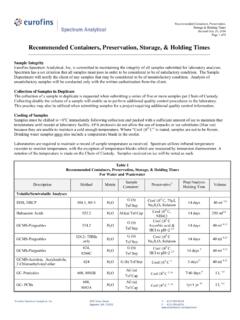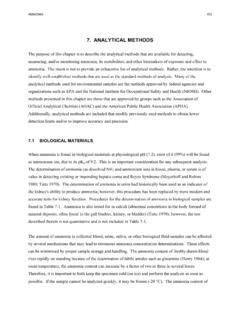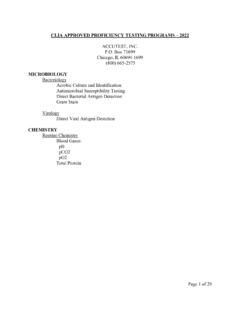Transcription of KETONES I 1300 - Centers for Disease Control and Prevention
1 KETONES I 1300 TABLE 1 MW: TABLE 1 CAS: TABLE 1 RTECS: TABLE 1 METHOD: 1300, Issue 2 EVALUATION: FULLI ssue 1: 15 May 1989 Issue 2: 15 August 1994 OSHA/NIOSH/ACGIH: Table 1 PROPERTIES: Table 1 COMPOUNDS: acetone 2-hexanone(SYNONYMS:Table 1) cyclohexanone methyl isobutyl ketone diisobutyl ketone 2-pentanoneSAMPLINGSAMPLER:SOLID SORBENT TUBE(coconut shell charcoal, 100 mg/50 mg)FLOW to L/minacetoneothersVOL-MIN: L 1 L -MAX: 3 L10 LSHIPMENT:MIBK must be refrigerated [1]SAMPLE STABILITY:unknownFIELD BLANKS:2 to 10 field blanks per setMEASUREMENTTECHNIQUE:GAS CHROMATOGRAPHY, FID ANALYTE:compounds aboveDESORPTION:1 mL CS2.
2 Stand 30 minINJECTION VOLUME:5 LTEMPERATURE-INJECTOR:250 C -DETECTOR:300 C -COLUMN: 50 C to 170 C @ 10 /minCARRIER GAS:N2 or He, 30 mL/minCOLUMN:glass ( m x 6-mm ID), packed with10% SP2100 Carbowax 1500 onChromosorb WHPCALIBRATION:standard solutions of analyte in CS2 to 10 mg per sample [2]ESTIMATED mg per samplePRECISION (S r):see EVALUATION OF METHODACCURACYRANGE STUDIED, BIAS, OVERALL PRECISION (S rT),and ACCURACYsee EVALUATION OF METHODAPPLICABILITY: This is intended as a general method for the KETONES listed above. If only certain compounds are of interest,the instrumental conditions can be changed to maximize instrument response for these : None reported.
3 Alternate columns, , 10% SP-2100 or DB-1 fused silica capillary, can be METHODS: This method combines and replaces Methods S1, S18, S19 and S20 [3], S178 and S358 [4], and 1300(dated 2/15/84).NIOSH Manual of Analytical Methods (NMAM), Fourth Edition, 8/15/94 KETONES I: METHOD 1300, Issue 2, dated 15 August 1994 - Page 2 of 5 SAMPLING: disulfide (CS2) GC grade.* , reagent , , , filtered, dry.*See SPECIAL : : glass tube, 7 cm long, 6-mm OD, 4-mm ID, flame-sealed ends with plastic caps,containing two sections of activated (600 C)coconut shell charcoal (front = 100 mg; back= 50 mg) separated by a 2-mm urethane foamplug.
4 A silylated glass wool plug precedes thefront section and a 3-mm urethane foam plugfollows the back section. Pressure dropacross the tube at 1 L/min must be less kPa. Tubes are commercially available. sampling pump, to L/min,with flexible connecting tubing. chromatograph equipped with FID,integrator and column (page 1300-1). , 2-mL, glass, PTFE-lined crimp caps. , 10- L, readable to L. , TD, 1-mL, with pipet bulb. flasks, 10-mL. SPECIAL PRECAUTIONS: Carbon disulfide is toxic and an acute fire and explosion hazard (flash point= -30 C); work with it only in a each personal sampling pump with a representative sampler in the ends of the sampler immediately before sampling.
5 Attach sampler to personalsampling pump with flexible at an accurately known flow rate between and L/min for a total sample size to 3 L for acetone or 1 to 10 L for the other the samplers and pack securely for the front and back sorbent sections of the sampler in separate vials. Discard the glasswool and foam mL CS2 to each vial. Attach crimp cap to each to stand 30 min with occasional AND QUALITY Control : daily with at least six working standards over the range to 10 mg analyte known amounts of analyte to CS2 in 10-mL volumetric flasks and dilute to the together with samples and blanks (steps 11 and 12).
6 Calibration graph (peak area vs. mg analyte). desorption efficiency (DE) at least once for each lot of charcoal used for sampling inthe calibration range (step 8). Prepare three tubes at each of five levels plus three and discard back sorbent section of a media blank a known amount of analyte or of a standard solution of analyte in CS2 directly ontoNIOSH Manual of Analytical Methods (NMAM), Fourth Edition, 8/15/94 KETONES I: METHOD 1300, Issue 2, dated 15 August 1994 - Page 3 of 5front sorbent section with a microliter the tube. Allow to stand (steps 5 through 7) and analyze together with working standards (steps 11 and 12).
7 A graph of DE vs. mg analyte three quality Control blind spikes and three analyst spikes to insure that the calibrationgraph and DE graph are in gas chromatograph according to manufacturer's recommendations and to conditions givenon page 1300-1. Inject sample aliquot manually using solvent flush technique or :If peak area is above the linear range of the working standards, dilute with CS2,reanalyze, and apply the appropriate dilution factor in peak the mass, mg (corrected for DE) of analyte found in the sample front (Wf) and back(Wb) sorbent sections, and in the average media blank front (Bf) and back (Bb) : If Wb > Wf/10, report breakthrough and possible sample concentration, C, of analyte in the air volume sampled, V (L):EVALUATION OF METHOD.
8 The methods on which this method was based were validated under NIOSH Contract CDC-99-74-45 [5]. Desorption efficiency was checked by spiking known amounts of the compounds (either neat or insolutions with CS2) on coconut shell charcoal. Samples were generated for acetone, cyclohexanone,2-pentanone, and methyl isobutyl ketone by heating a quantity of the liquid to just below its boiling pointin a 3-necked, 500-mL round bottom flask. The compound was carried through a fixed-temperaturecondenser to the concentrations. Samples were generated for diisobutyl ketone and 2-hexanone usinga syringe pump which delivered the compounds to a heated glass-lined inlet which was swept withnitrogen, carrying the vapor to the mixing chamber.
9 Low-level desorption efficiency checks showed theDEs to be 70% and 76% for and mg/sample respectively for cyclohexanone and 87% mg/sample of MIBK [2]. Results of the evaluation experiments are given Manual of Analytical Methods (NMAM), Fourth Edition, 8/15/94 KETONES I: METHOD 1300, Issue 2, dated 15 August 1994 - Page 4 of 5 Range, mg/m3 MeasurementMethodOverall PrecisionBreakthrough1 Range, mg/sample Compound [2-5] (S rT) (L) (S r) DE2 AcetoneS1, 1271200 to 4500 to ( ) ( )CyclohexanoneS19 98 to 392 to ( ) ( )Diisobutyl ketoneS358145 to 582 to ( ) ( )2-HexanoneS178188 to 790> to ( ) ( )MIBKS18208 to 836 to ( ) ( )2-PentanoneS20395 to 1570 to ( ) ( )
10 _____1 5% breakthrough, L/min at high end of concentration range in dry Averaged over mass range :[1]UBTL Report, Sequence #5528-J (NIOSH, unpublished, Oct. 2, 1986).[2]Williams, Karen, Desorption Efficiency Determination for Cyclohexanone and Methyl Isobutyl Ketone,NIOSH/MRSB, Unpublished (1986).[3]NIOSH Manual of Analytical Methods, 2nd. ed., V. 2, S1, S18, S19 and S20, Department ofHealth, Education, and Welfare, Publ. (NIOSH) 77-157-B (1977).[4]Ibid, V. 3, S178 and S358, Department of Health, Education, and Welfare, Publ. (NIOSH)77-157-C (1977).[5]Documentation of the NIOSH Validation Tests, Department of Health, Education, and Welfare,Publ.
















